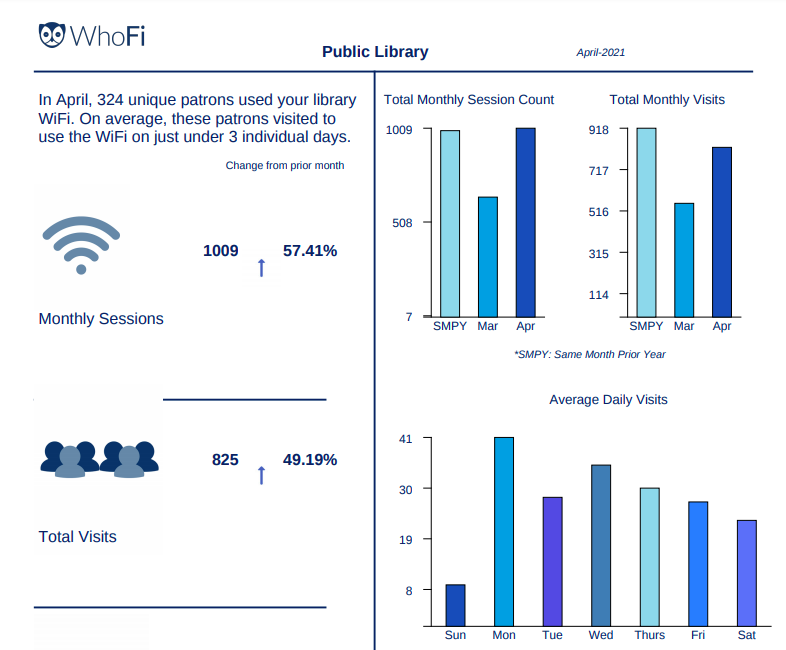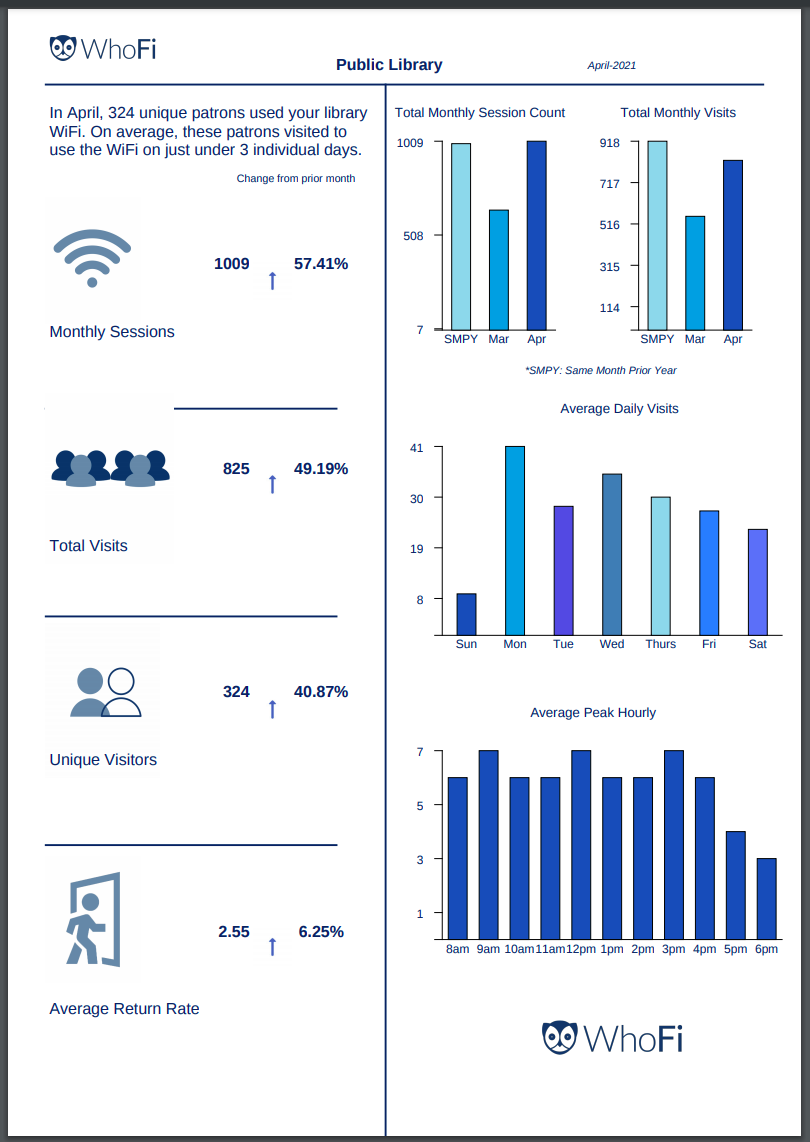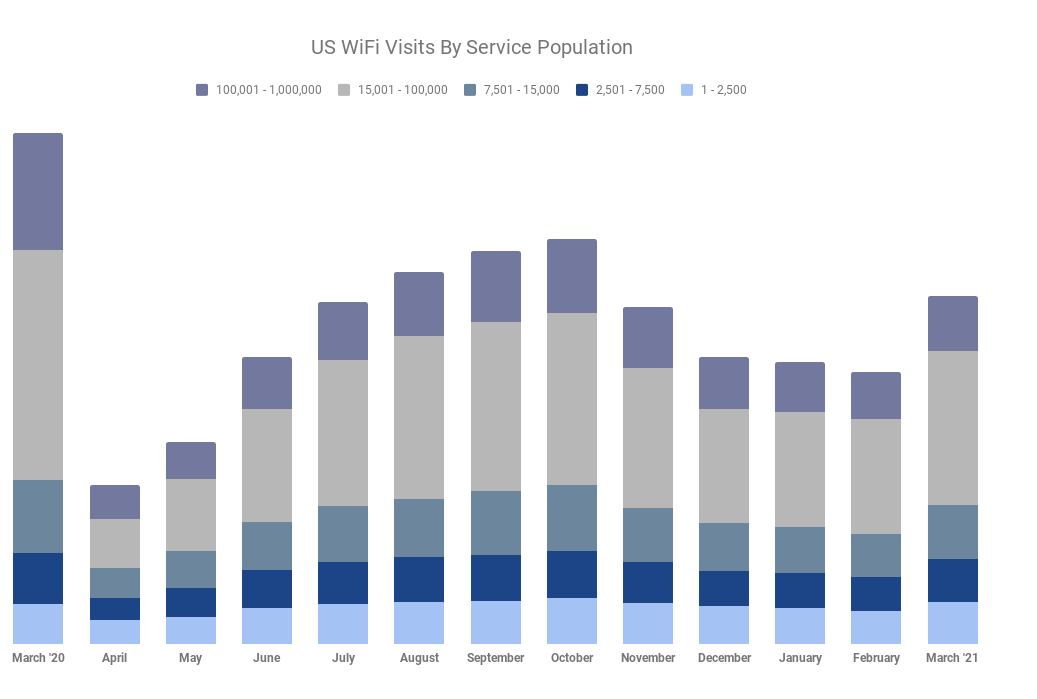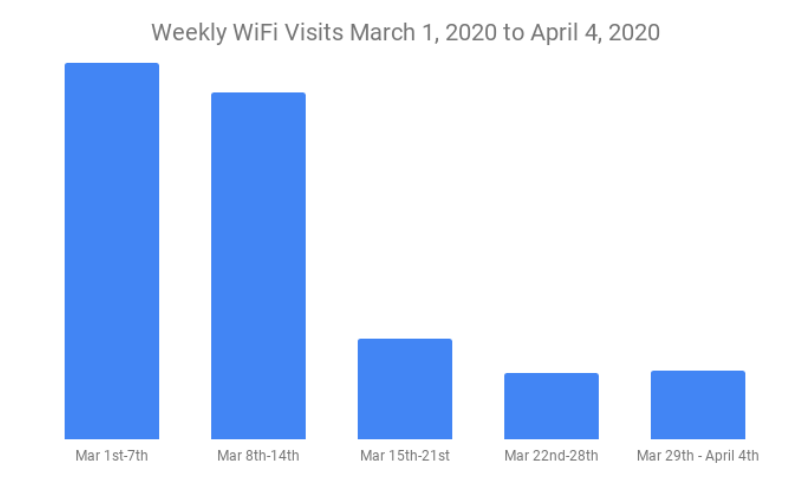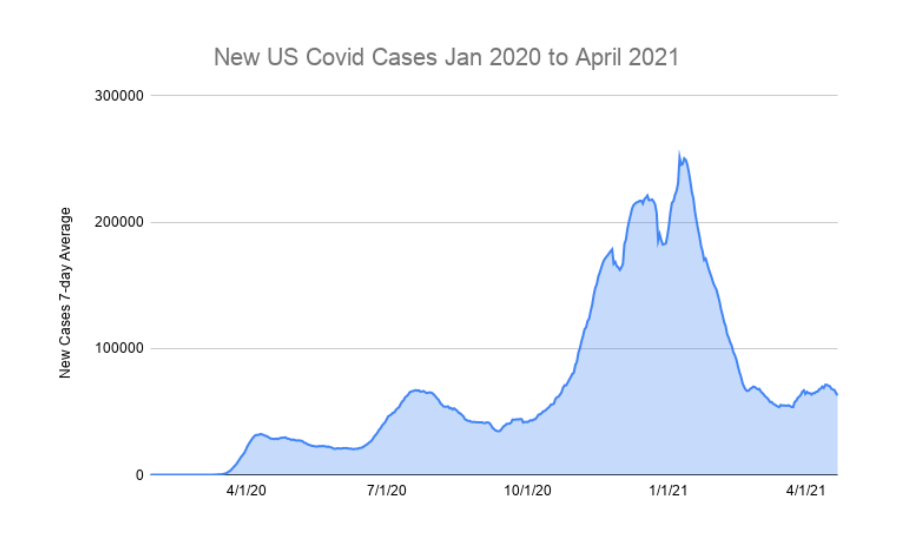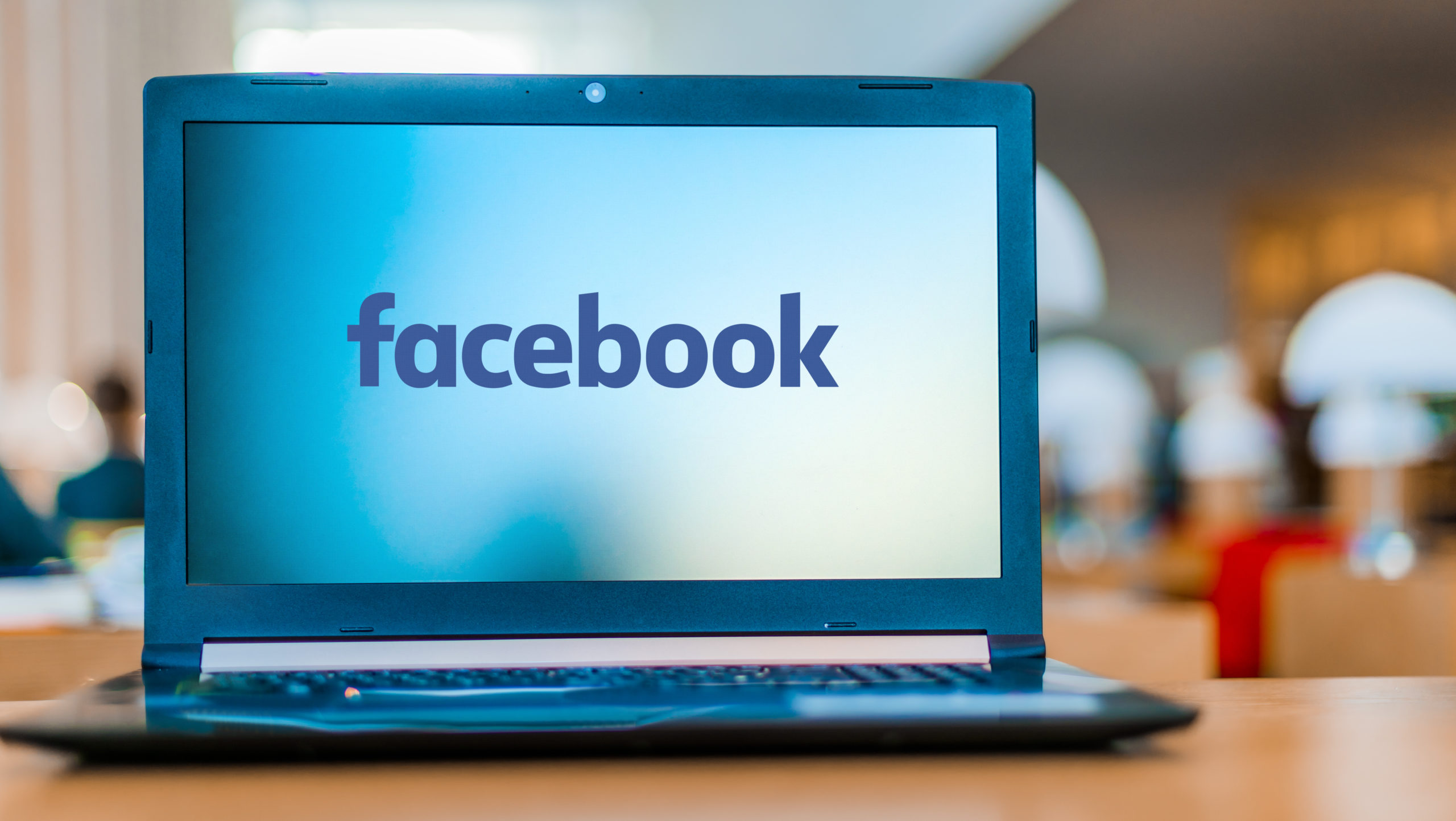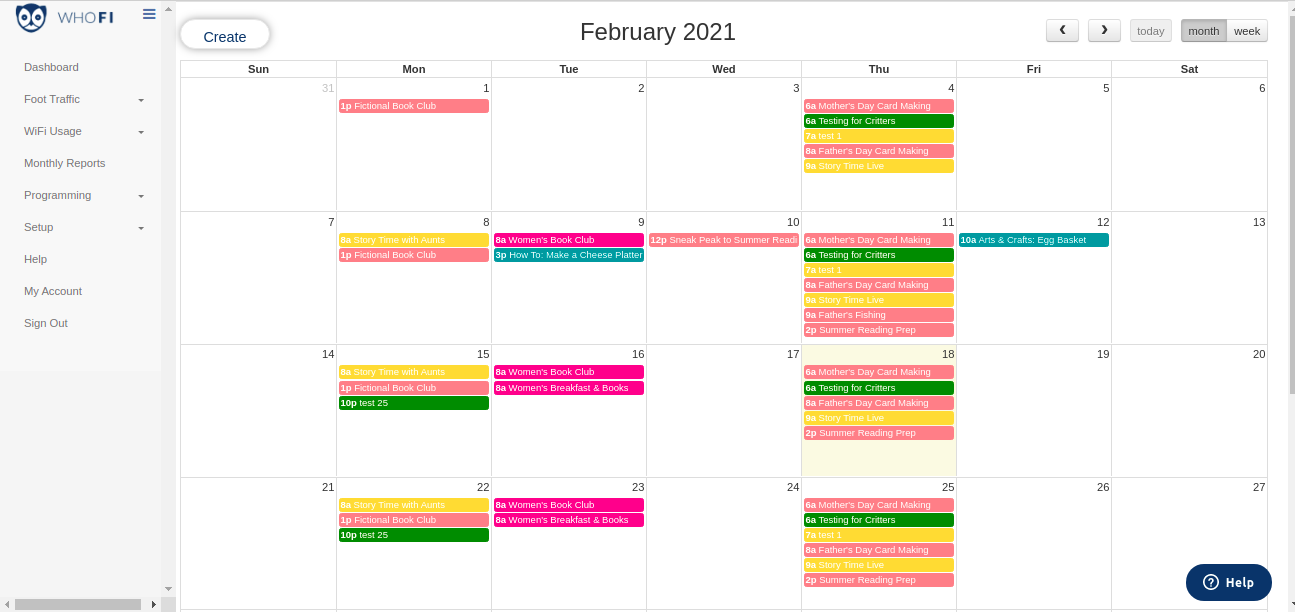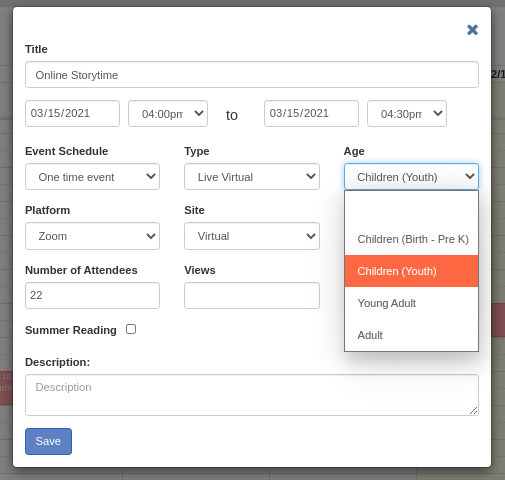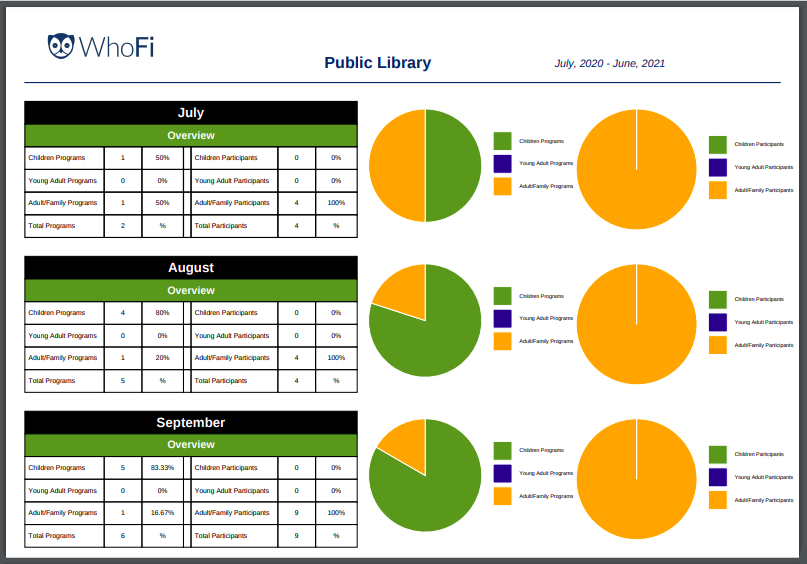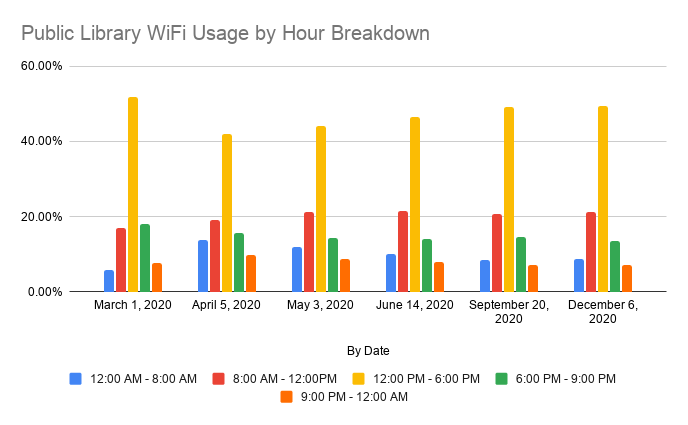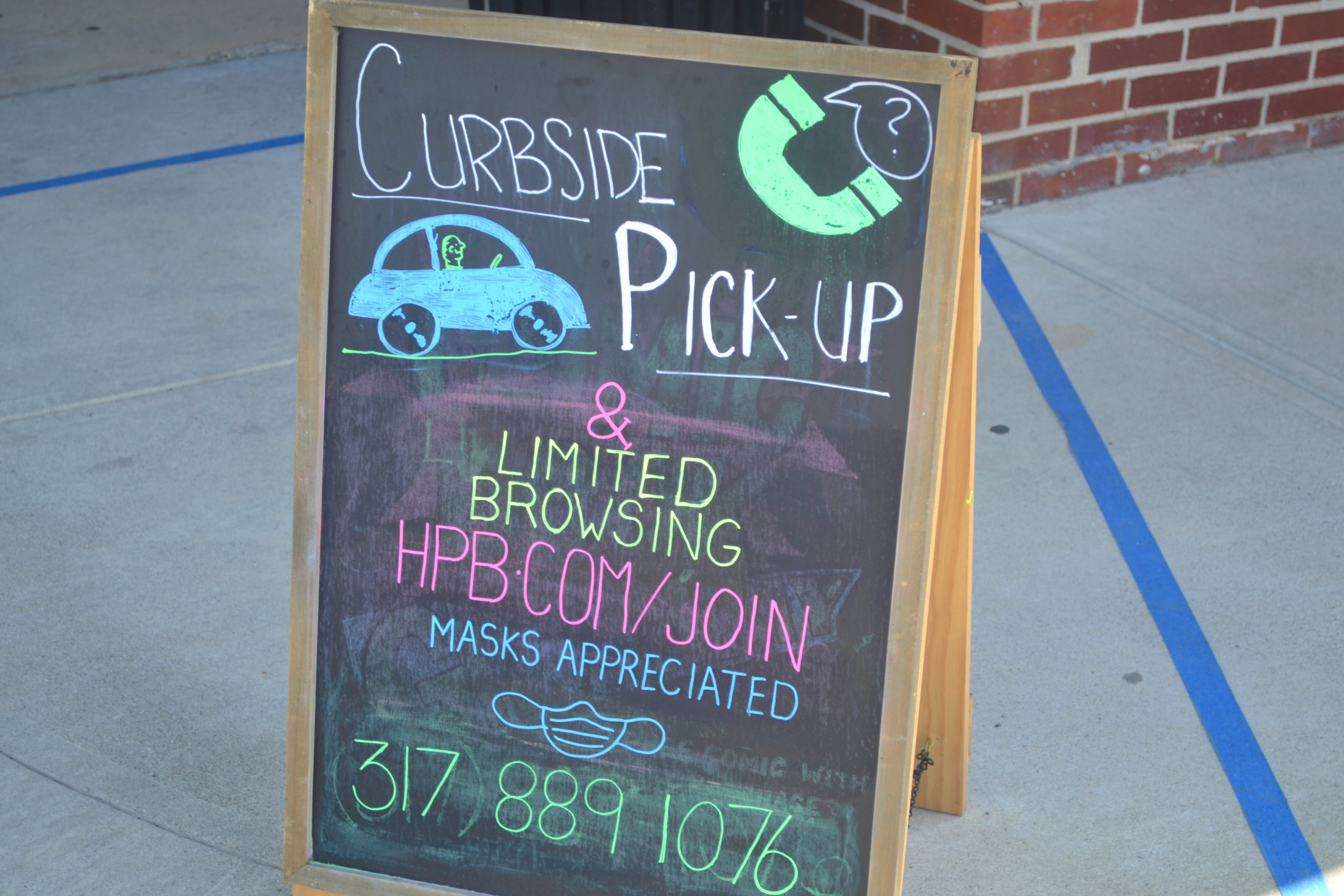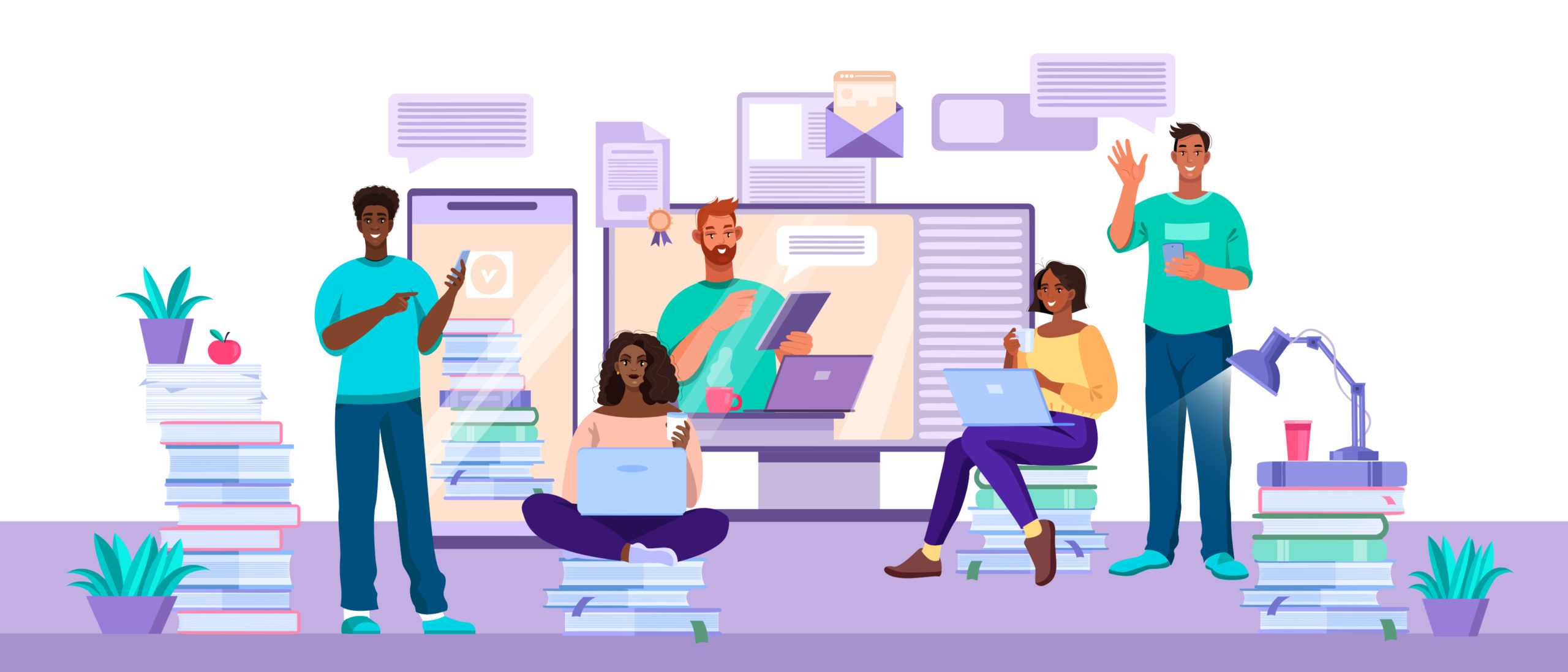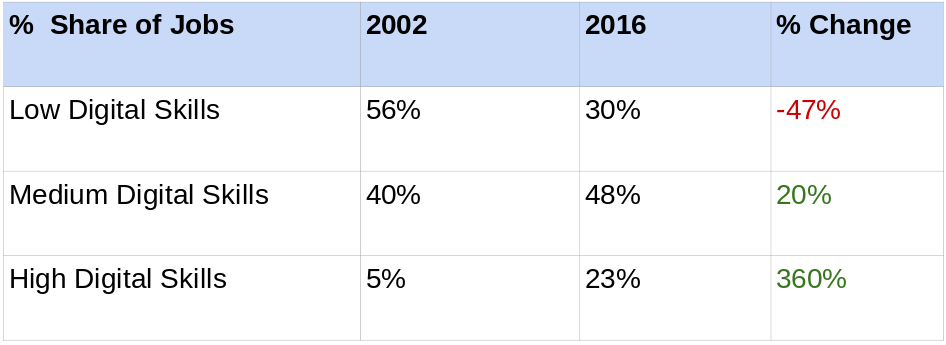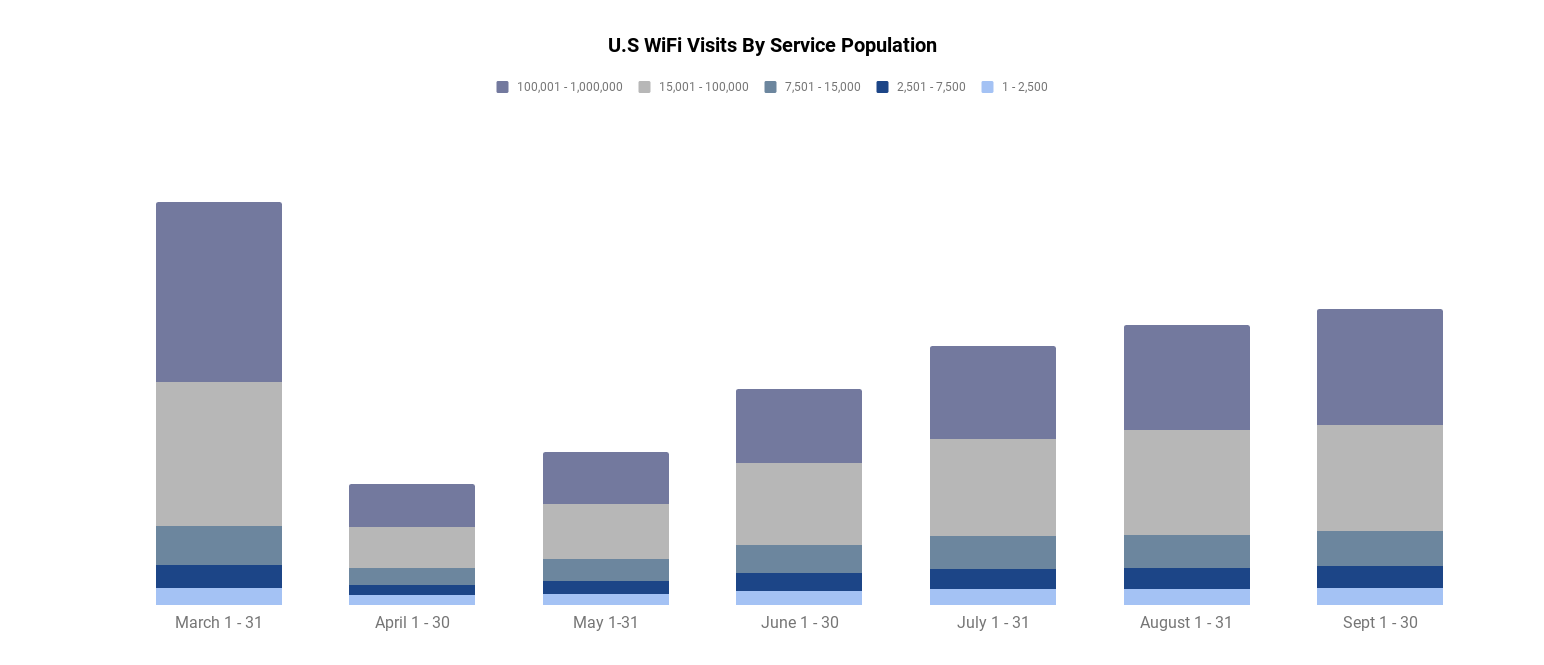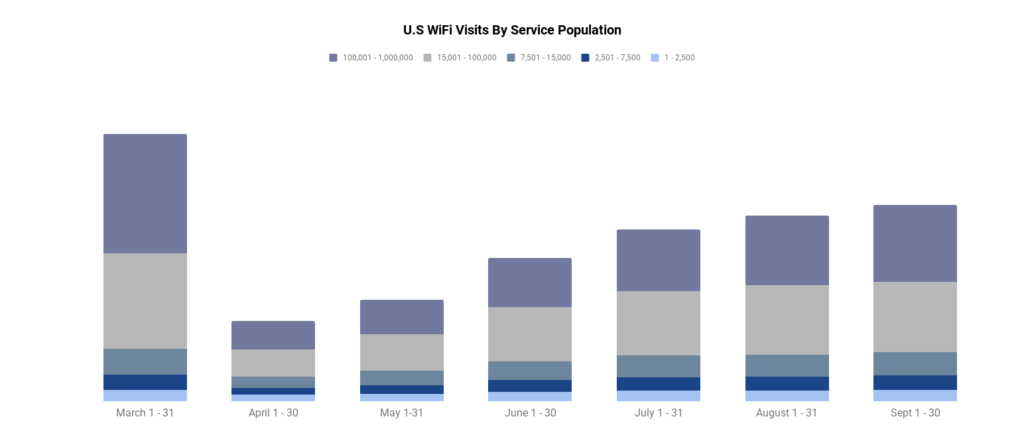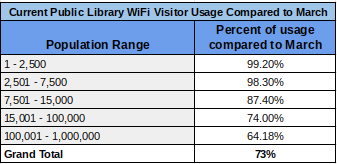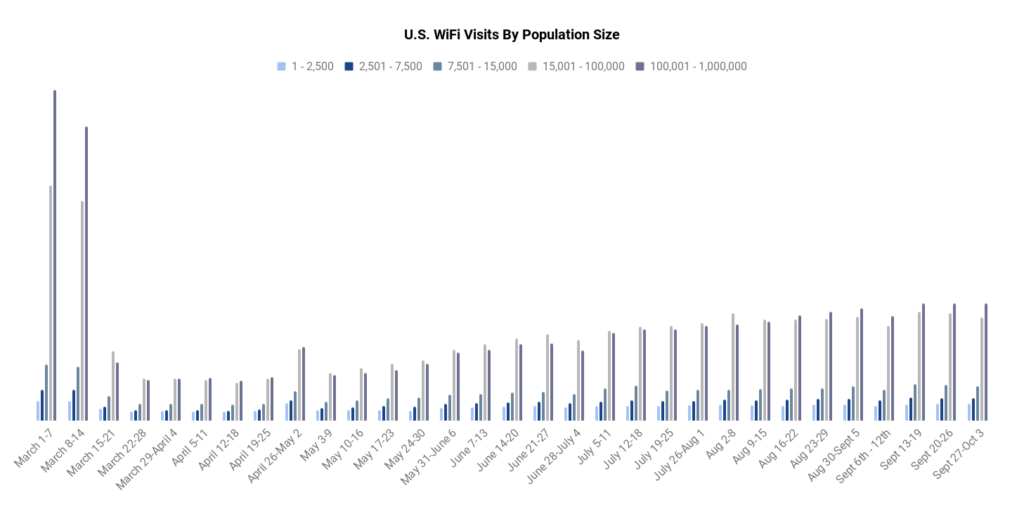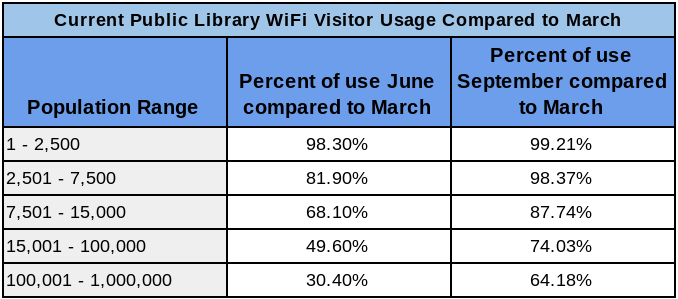Monthly At A Glance Report Simplifies Board Reporting
WhoFi is happy to announce the release of the monthly At A Glance Report for all partner libraries.
Through conversations with our public library partners, it became clear that there was a need for a simplified board report surrounding their patron WiFi usage. Previously library directors used another WhoFi report, the Trend Summary, to show WiFi usage. The Trend Summary Report is a detailed view of the monthly usage and is great for digging deeper into usage patterns.
While directors enjoy the detail contained in the Trend Summary, they expressed a need to have a one-page report that provides a high-level view of what had taken place. With the help of our library partners, we created our newest board report called At A Glance.
The At A Glance Report takes the numbers on the Trend Summary and turns them into a story visually and verbally. Libraries use this new report to hand out during board meetings. Boards are then able to quickly understand the impact that WiFi is having on their community both in the most recent month and over time.
Here’s an example of an At A Glance Report.
At A Glance contains a brief description of what took place in the most recent month in addition to providing comparisons to the prior month and the same month in the prior year. These insights and quick comparisons help frame progress and help boards and decision-makers easily assess trends. Should the boards have questions based on the At A Glance report the director is able to reference the Trend Summary to help provide more detailed information.
The At A Glance Report is now available in the Monthly Reports section for all single location, multi-branch, and multi-location systems. You can quickly print this out and give it to your board members during your next meeting.
We look forward to your feedback and the feedback from your boards on this latest offering. If you have questions about this new report or any of the reports available in the user dashboard, please contact our customer service team.
Public Library Insights One Year Into The COVID-19 Pandemic
The past year has brought many changes and challenges. And it’s also created an environment for growth. Faced with uncertainty, libraries rose to the challenge and adapted their services to meet the changing needs of their communities. In many ways, libraries are able to meet patrons' needs now even better than before. The flexibility of these new offerings made it easier to reach additional community members, and our library partners think these changes are here to stay. It’s helped libraries stay connected to their patrons even when separated physically. As we begin to emerge from the pandemic, WhoFi analyzed the data from our library partners to determine the effect of COVID-19 on patron WiFi usage. This special report includes our findings from March 2020 to March 2021.
Reflecting back on a year of pandemic life, how has COVID changed library WiFi use?
The COVID-19 pandemic certainly brought about many changes in the way patrons interact with their libraries and how libraries serve their communities. When analyzing WiFi insights data and looking for usage trends, there are some clear fluctuations in use that seem to correlate with particular service areas, important timelines in the pandemic, and library outreach efforts.
One interesting data point, perhaps the most relevant when it comes to library advocacy for WiFi access expansion, is that library WiFi usage was never zero. WiFi use did decline, especially early in the pandemic, but then began to steadily increase across cities and towns of all population sizes. A PLA survey report showed that 98% of libraries closed to the public in March due to COVID-19. However, the WiFi data from our insights showed a national decrease in WiFi usage of only 67%. This shows patrons were accessing the library WiFi in other ways besides actually being in the physical library building. The same PLA survey also noted that 81% of libraries decided to leave their WiFi on and available to the public. Since a high number of libraries left WiFi available to the public, the drop in usage of only 67% makes sense.
The digital divide became the digital Grand Canyon.
Public libraries have consistently worked to close the digital divide. But as the pandemic continued, it became clear that the digital divide was becoming bigger. There was a difference in how the pandemic was experienced between those with access to a computer and high-speed internet and those without. As schools finished their academic year in May of 2020, heartbreaking stories of children sitting all day in fast-food parking lots with their laptops started to emerge. They didn’t have internet access at home, and they were just trying to finish their schoolwork which was now online.
Many libraries took it upon themselves to address this issue within their communities with the resources they had. Many libraries left WiFi on 24/7, removed or provided passwords to their WiFi, moved routers closer to the window, and began promoting their free WiFi service. Some libraries installed WiFi hotspots to extend to the parking lot, creating a ‘drive-in WiFi’ trend. Some libraries also sent out loaner 4G hotspots or installed fixed line internet connections in some neighborhoods. This helped people attend online classes, do work, or just stay in touch with friends and family.
The PLA survey showed that 81% of libraries left their WiFi on while closed, and 12% expanded or added to their WiFi service in response to the pandemic.
These efforts seemed to make a difference and were reflected in the data as WiFi usage began to steadily climb in Spring 2020.
Public libraries adapted quickly to meet community needs.
In addition to improving community internet access, libraries made changes to multiple aspects of their patron services. Public libraries provide immense value to the community through education, resources, and programs. The pandemic showed that the library community is more than just a building – it’s the people. And when buildings close and people are sheltering in place, the community moves online and finds other ways to stay connected.
Libraries were quick to adapt their services to meet safety precautions – offering online library card registration, curbside pick-up for books, crafts and STEM projects, online storytimes, expanded digital resources, easier access to library cards, and curbside pick-up for other essential services (unemployment forms, PPE, food, diapers, and so much more).
When did patron behavior begin to change?
Were there key events that could have made a difference in patron behavior and WiFi use?
Based on our data and national timeline of events, it seems so. Our report on the timeline of events shows a sharp decline in WiFi use beginning March 11, 2020 with the sharpest declines occurring on March 13th, 14th, and 15th. March 11th was the day the NBA suspended its season after a Utah Jazz player tested positive for coronavirus, and also the day that Tom Hanks and Rita Wilson tested positive. March 12th was the day that MLB, NHL, and NCAA basketball announced suspension or pause of their events. Then, on March 13th, President Trump declared a national state of emergency. At this point, many local governments issued shelter-in-place orders, effectively closing many library locations.
As always, correlation does not equal causation. It’s unclear if these national events were the cause, a tipping point, or a random occurrence that correlated with the data. In either case, it is clear that a trend change to a “new normal” occurred between the days of March 11th and March 15th as shown through the WiFi data in the chart below.
What does patron WiFi usage look like now?
Our data shows that after the initial drop in WiFi usage in March, trends steadied and then began to rise around April 26. The total number of visits wasn’t as high as it was prior to shut-downs, but shows continued use despite building closures. By the end of June, the national WiFi usage rates had increased 40%, and have had another 35% increase from June to September. By the end of Q3, national WiFi usage in public libraries was at 73% of what it was in March.
Q4 showed a slight decrease in usage. Although, there is usually a seasonal decrease in WiFi usage during the winter months. However, coronavirus cases also spiked in much of the U.S. between the middle of October 2020, until decreasing significantly towards the middle of February 2021 as shown here:
It is unclear whether it was the colder weather, the virus, or some other factor causing the decrease through the winter months. However, as vaccinations were deployed, reopenings occurred, and the weather got warmer, there is a new higher WiFi usage trend that appears to be starting in March of 2021.
The graph below shows an overview of monthly WiFi usage from March 2020 to March 2021 sorted by population size. Now, at the end of Q1 2021, WiFi usage is at 68% compared to March 2020 and climbing back to Q3 usage rates.
Did population size affect WiFi usage?
Our data showed that library WiFi use in both urban and rural service areas decreased, but urban areas had a much greater drop. And throughout the pandemic libraries in rural areas had a much faster return to pre-pandemic WiFi usage rates compared to libraries in urban areas. In fact, by November 2020, rural libraries regained nearly 100% of their WiFi use (compared to March 2020.)
Patrons in rural areas often rely on the public library as their main source of internet, and we’ve seen this reflected in the data. The table below shows the percentage of WiFi use libraries are experiencing in March 2021 compared to March 2020. You’ll notice that rural communities with populations under 2,500 are being used even more now than they were when the pandemic started. Libraries are anchor institutions from which services such as WiFi can be easily distributed to communities that lack infrastructure. Libraries can use this information to advocate for funding to secure high-speed broadband internet access and other technology resources for their patrons.
What does this mean for these libraries and how can they best serve their community going forward?
The data is clear: WiFi is a valuable resource the libraries offer to help their communities. As libraries begin to prepare for the year ahead and planning for the future, tracking WiFi usage could prove beneficial for library advocacy efforts, operational improvements, strategic planning, and accurate reporting for the PLS survey. Having such information can give libraries the tools they need to secure funding to provide more and better services, and even help guide decisions on how to best use their space.
Carrying insights into the future.
This data solidifies the importance of public libraries within the communities they serve. Even before the coronavirus outbreak, lack of internet access was a big problem – now it’s critical. Throughout the pandemic, public libraries have continued to help patrons stay connected to school, work, and family. In addition, they continue to help provide social service assistance for their community members through filing for unemployment, Census registration, and job searches.
As we begin to emerge on the other side of this pandemic, the knowledge we’ve gained from WiFi insights will continue to influence how libraries interact with the communities they serve.
Questions about how to get insights for your library? Schedule a demo with our team.
Getting Social While Social Distancing
Librarians are people who want to connect with their community. Through library services, outreach, programs, and much more, libraries and librarians are beacons to all communities. So when library doors closed due to COVID-19, this was tough on the community and the librarians who thrive on serving and connecting.
In times of crisis and economic recession, people need the library more than ever. They need someone to help connect them with free resources, social services, a safe place to use the internet, resources for job placement, or simply connection. Humans are wired for connection, after all.
We need this and shared positivity, hope - a lighthouse to guide us through troubling times. What better organization to provide this than our public libraries?
Just because we’re not able to physically be in the public library space, there are still ways to stay connected, enjoy personal interactions, and benefit from the services our libraries offer. Libraries continue to rise to the occasion and meet community needs through online programming and digital resources.
This post covers how social media is being leveraged to maintain and strengthen the connections libraries have with community members. Some of our library partners have reported an even higher engagement rate since more people can access programs at their convenience.
Using Facebook To Engage Online
Facebook is a great social platform that can be used to host community engagement pieces. There are various ways to use the platform that combine text, images and video (that can all be stored for later reference by your patrons), to create an enriching experience. It’s also an opportunity for even more program attendance than you may have gotten pre-COVID. With no space restrictions, time considerations, or scheduling issues, more people are able to attend online programs hosted on the Facebook platform.
5 ways your library can use Facebook
- Remind patrons of the services you’re offering and how. For example, is curbside pick-up available? Are you offering limited office equipment use? Have you expanded your digital offerings? Are you offering curated content and book bundles? Whatever you’re doing, share it on Facebook.
- Promote library card sign-ups. Demonstrate how easy it is to get one online now and what you can do with it.
- Remind patrons of the free WiFi service available and how to access it.
- Migrate in-person programs to the online space. Storytimes, book clubs, even kid's crafts can all be recreated and shared online.
- Interact with other local community spaces, parks, institutions, organizations, etc to create alliances and promote the library services that help the community.
Ideas for Facebook Live content
Storytimes
This is a popular program that translates well to the online space. We’ve heard from some of our partners that they have hundreds of people attend online storytimes now. Where pre-pandemic, the in-person attendance was smaller. How do you do an online storytime? Go about it the same way you would normally: choose your stories, create your settings (using plushies, decorations, props etc), read and engage with your tiny patrons as you normally would.
Live music
Libraries that hosted live music sessions during the day pre-pandemic can still showcase local talent using Facebook Live. Reach out to your local musicians and talk about the opportunity for collaboration. Or perhaps someone on the library staff is musically inclined and would host a live show? A teen band or performer would likely love the opportunity for an online audience. And it could attract more youth to the library services.
Crafting
Crafting sessions for adults and kids alike are a popular library event. All kinds of DIY craft demos are shared on YouTube, so why not Facebook Live, too? A sewing tutorial for a mask or how to make a mask without sewing would be great ideas. Any type of craft your library would normally make available for kids is another good idea. Post about the Live session ahead of time and consider making supplies available with curbside pick-up.
Instructions
Demonstrate how to download library-related apps or use online registries like ancestry.com, all of which are free with your library card. Consider a walk-through of applying for social services or the video version of in-person help you’d normally provide within the library building.
Bring in experts
Connecting the community to what they need is what libraries are all about. Host a live session with guests who specialize in mental health to discuss topics related to coping during a pandemic. Another group that could benefit from a connection is caregivers. Caring for young, old or sick family members during this time adds an extra layer of difficulty and complexity to an already tough job. For example, consider what kind of challenges COVID presents for people with Alzheimer's, cancer, elderly parents, special needs parents, etc. Partner with local chapters of an organization, or a social worker from a hospital or whatever’s relevant, to bring information to your patrons.
Self-care
Self-care can take many forms, especially now. It includes relaxation techniques. Have a yoga instructor host online classes. Do you know someone who makes their own body products? Ask them to host a demo about how to make your own candles, lotion, or something. Consider having these supplies available for pick up at your library.
Tips for using Facebook Live
- Make sure you have a strong WiFi connection for a broadcast that’s as clear, high-resolution, and stable as possible. Increased online programming is another reason why libraries need high-speed internet.
- If shooting on your phone, use a tripod to ensure a steady stream (and prevent your phone from toppling over mid-shoot!)
- Engage with your audience. Say hello, mention commenters by name and answer questions,
- Tell people ahead of time when you plan a Live stream. Post to your Facebook about the Live session, what it is, when it is, how to watch a couple of times beforehand, and then a reminder shortly before. This ensures your audience has time to plan and remember the event.
- Remind people they can watch the Live stream from your Facebook page under ‘videos’ even after you’ve ended it.
- Be creative and go Live often. The more content you create, the more comfortable you’ll feel, and the more interaction you’ll get from the community.
- Ask the community what kinds of things they’re interested in. Create a Facebook Poll and use that as guidance to come up with new content.
Action items to start using Facebook Live
- Set up a Facebook page. If your library needs to set up a Facebook page, this is a helpful guide to get you started.
- Set up admins to the page (anyone who will be responsible for creating and posting content).
- Download the Facebook app to your phone and practice using it as the library.
- Use the app to create and post content when appropriate.
- Discuss with the library team ideas for Facebook Live content and create a document to share and save ideas.
The most important part of using social media is to have fun, be yourselves, and be creative. Your patrons will appreciate the effort and connection. And these are practices that you can continue to use even after the pandemic. Consider this an opportunity to expand the reach of your public library to do even more good.
Curious to know more about how you can monitor online program attendance? Book a demo with our team today!
Introducing the WhoFi Community Calendar
Community Calendar is the program reporting tool for modern libraries
Easily Track Your Library’s Programs For Accurate Reporting
Libraries are adapting to meet changing community needs by connecting with patrons online and in-person. The Community Calendar offers a replacement to cumbersome tallying methods. It also helps libraries better understand their patrons to further improve their service.
What is Community Calendar?
Community Calendar is a reporting tool to help libraries understand their programming and better serve the community. It is an easy-to-use system to schedule programs and view insights - all in one place. This tool makes it easy to schedule, manage, and count attendance at all programs and events.
How does it work?
Create one-time or recurring programs in your dashboard. Enter the program’s PLS type, category, platform, and other relevant information. After the program has taken place, enter attendee information. Attendance information shows seamlessly through categorized, accurate reporting.
You can also account for views to recorded programs that are posted online later. This new tool is designed to help libraries plan and monitor both their online and in person programming attendance.
What does Community Calendar do for your library?
- Helps libraries plan programs in advance for both online and in person events. This helps to get a full view of the community calendar.
- Alleviates the need for hand-tallying and storing numbers on paper.
- Auto-generates reports for easy end-of-year reporting. No more complicated spreadsheets and calculators - we do it for you!
The Community Calendar reduces the burden of tracking, organizing, and identifying program specific effectiveness. It also helps with stakeholder and board reporting. The new feature also allows multiple users access to enter their department’s programming all in one place. It also helps library directors articulate the community impact they are having through the programs being offered. This information helps libraries when it comes to advocacy efforts.
Interested in learning more about Community Calendar? Click here to schedule a demo.
Libraries Staying Connected To Patrons With Online and Outdoor Events
As the coronavirus pandemic continues, libraries continue to adapt and find creative ways to stay connected to their communities. From drive-in WiFi, grab and go book pickup, and modified services and programs, libraries are going above and beyond to meet the needs of patrons while staying connected online and outdoors.
If your library has outdoor space or a local park area available (and recommended safety guidelines are followed) outdoor programming paired with an online component would be a great way to stay connected to patrons. Many programs that were previously held indoors can be moved outdoors (when weather appropriate) like storytime, art class, yoga, or crafting. These can also be streamed online to your social media channels just as they would be indoors.
We’ve compiled some tips that can help your library plan for your outdoor and online programming.
8 Tips For Successful Outdoor Programming
- Plan Ahead
This may seem like a no-brainer, but along with your regular planning, brainstorm with some colleagues and ask, “What could go wrong?”
What will you do if participants don’t follow protocol? How will you handle participants who are exhibiting illness symptoms? Think about all the things that could happen and arm yourself with contingency plans.
- Do a practice run-through
Prepare your program as you would normally indoors and think through any adjustments that need to be made for an outdoor venue. Do you need a tent? Chairs? Tables? If you’re going to be recording and sharing to your social media channels plan who will record, upload, and do any promotion of the event.
- Limit Registration
To ensure your outdoor program meets the legal gathering limits and you have enough room to social distance, require participants to register and place a limit on registration.
- Set Safety Guidelines
Make sure to clearly state your safety guidelines to inform patrons. If masks are required, have disposable masks on hand for those who forgot. You could even have printed out instructions for DIY at-home face masks so patrons can make their own at home.
If social distancing measures will be in place, have clearly marked traffic areas, circles for seating, and signage explaining the guidelines. Having a visual reminder of where to sit and stand is helpful for everyone, especially the littlest patrons. Having a few hand sanitizer stations would be a good idea, too.
- Provide Individual Supplies
If you’re hosting a craft activity, prepare individual supply kits ahead of time for each person. This way everyone gets what they need and can maintain social distancing.
- Test Your Setup
Make sure to give your program a run-through before the actual event. Since people will be spread out, consider using a microphone so you can be heard and test the audio. If you’re hosting a storytime, consider books with big pictures and words, or create big posterboards with the print out images from the book, or printouts for each family so they can follow along on their socially distanced seating area.
- Communicate
As you start to promote your program make sure to communicate the guidelines and what patrons should expect. This helps attendees follow safety measures and feel safe. Communicate the guidelines before and during the event.
- Adjust as needed
As you offer more programs you’ll get a feel for the flow of things and what needs to be adjusted, what’s working, and how to move forward. This is uncharted territory so do what’s best for your library and patrons to make sure everyone has a good time and is safe.
More Ideas To Stay Connected Through Outdoor Programming
Patrons are looking for new and fun things to do, especially families, so offering a safe way to stay connected online and outdoors helps strengthen your ties to the community. It's also a great way to promote your library's vast array of books. You could pair activities with available books and resources for additional learning and fun. Create book bundles for every age group related to the program you’re offering.
- Nature photography( presented by a staff amateur photographer)
- Biking, presented by a local biking organization
- Historic walking tours
- Wildflower hikes
- Host a gardening program – grow plants in little cups then plant them outside.
- Have a nature crafts program.
- Host an “animals in winter” program. If possible share some of their furs and talk about hibernation.
- Make a collage from things found in nature.
- Host a program about recycling at the library. Promote your library’s recycling program and take it one step further this year.
- Host a program about a specific animal or season and offer a craft to coordinate with that theme
Even if you don’t offer any programs on outdoor recreation, you can still maintain lists of recommended websites that have helpful links to local parks and recreation groups or nearby outdoor attractions. These selections are great for locals looking for more information on their area and for visitors who want to enjoy the natural elements of your community.
WhoFi provides libraries with wireless session counts, for advocacy, operational improvements related to the patron experience, and for the annual PLS and state surveys. If you want to learn more about staying connected online and outdoors, or how libraries can use WiFi insights to improve patron services, schedule a demo to see how it all works.
How the time of day patrons use WiFi is changing
Free WiFi at public libraries is an often used resource for many patrons. The pandemic is causing changes in how libraries operate and how patrons use library resources. This post covers how the pandemic has caused changes in the times of day that Free WiFi at public libraries is utilized. We show the WiFi usage times from before the pandemic in March of 2020. We then further show how the times have changed throughout the year 2020.
The Data
WhoFi is a leading provider of Wireless Session Counts and other WiFi statistics for public libraries and community spaces. The data shown represents WhoFi’s public library partners across 23 states. Always on equipment like wireless routers, printers, and other always on devices were excluded from these statistics. The samples were taken from specific weeks Sunday through Saturday during the course of 2020.
What Changed
Before Covid, the hours of noon to 6pm were over 50% of the total WiFi usage for the day. Early evening and evening hours made up about 25-30% of the remaining WiFi usage. Morning hours before noon represented only about 20-25% of the WiFi usage. However, since the pandemic began and continuing until now, there is an increase in early morning hours WiFi usage. There is also a decrease in later hours WiFi usage.
Immediately following the March declaration of the pandemic, the noon to 6 pm hours dropped from 52% to only 42% of the total WiFi usage. While the midnight to noon hours increased 10% and the 6 pm to midnight hours stayed flat.
By December, 9 months into the pandemic, the noon to 6pm time frame is back to being used roughly 50% of the time. But the 6pm to midnight time frame now represents 20% of the usage, while the midnight to noon time frame represents 30% of the usage. There was an immediate and also now persistent shift away from evening usage and into more morning WiFi usage for patrons at public libraries.
It’s important to note that during the April time period, total WiFi usage had dropped to almost 40% of their March numbers at public libraries. By December, total WiFi usage at public libraries had recovered to roughly 70% of it’s previous usage. However, this change in patterns remains.
What is causing this
Seeing this change isn’t overly surprising. Although each library system is different, libraries across the country have adapted to the pandemic in a variety of ways. Many libraries have had their doors closed. However, they have also increased their resources outside of the building. For example they have increased WiFi speed and availability into parking lots as well as offering curbside checkout and pickups.
We don’t know exactly what is causing this shift in patron behavior. Some stories are that due to e-learning, students and parents are utilizing library WiFi in the morning now. This would include early morning book and activities pickups for remote learners and young children. Some other possibilities are that with increases in unemployment, adults searching for jobs or filling out unemployment claims online are also morning WiFi users. Further possibilities are that evening library usage often included night classes or social gatherings for students and patrons with day jobs. Many of these patrons have WiFi at home. As the night classes became virtual they no longer came into the building. So they are no longer represented in the data. Although it’s difficult to know for certain what has caused this shift, it is notable that this shift has occurred.
Conclusion
There has been an immediate and persistent shift in what times patrons utilize the WiFi at public libraries. The immediate shift was towards heavier after hours usage in general. The longer term shift is towards morning and early morning hours. We'll continue to report on this and see this trend continues as libraries fully reopen in 2021 and beyond.
Curbside Books And Free WiFi
Libraries across the country continue to adapt services to meet patron needs. When the coronavirus took hold in March and public library buildings closed to the public, services continued in a new, modified format. Two of the most popular library services born out of this public health crisis are curbside pick-up programs and outside of the building WiFi use.
Curbside programs offer patrons a way to access resources and materials. Libraries offering curbside pick-ups keeps books and other tangible resources in the hands of patrons.
Free WiFi opens a digital door for patrons who need internet access - this includes everyone in the community. Among those needing access to wireless internet are people experiencing homelessness, who may have a phone but no data plan. Members of the community without home access, or limited access, rely on the library as their primary source of internet. In fact, research states that 73 percent of public libraries are the only provider of free internet access. These reasons are why curbside pick-up and free WiFi are two of the most popular public library services.
An Increasing Need For WiFi
Since March, schools have moved to online learning and many jobs are being done remotely. In addition, just about everything is done online now, including job applications, bill payment, social services applications, and staying in touch with loved ones. An internet connection is essential in today’s digital world. Equally as important is the need for human connection - something librarians provide patrons on a regular basis. With many public libraries still closed or operating at a limited capacity, librarians provide this through socially distanced services like curbside pick-ups and free WiFi outside of the building.
Curbside Pickups
Many libraries have adapted their book check-out process to accommodate health and safety guidelines and allow patrons to continue checking out books. Curbside pickups are a new popular way for libraries to get books into patrons’ hands. Patrons use their library account to reserve books and follow their local branch’s pick-up guidelines to get the book(s). Some libraries take it a step further and create book bundles for readers of all ages. Patrons can personalize their bundles based on age and interest or ask their friendly librarian to hand-pick some amazing books just for them.
Libraries are offering more than just books in the curbside model, too. Office services like printing, copying, technology lending, and WiFi are also accessible from outside of the building. Check out more tips on how to boost library services while buildings are closed.
Ebooks and Digital Services (WiFi)
Libraries across the country have seen increases in library card applications and digital content lending since March. Libraries are making it easier to apply for a library card online and access these digital resources. The Libby app makes it easy to check out ebooks, audiobooks, films, and music. Many libraries report seeing an increase in wireless sessions since the start of the pandemic. As reported in our COVID data, our partner libraries have regained 73% of their WiFi usage since March, on average. In conversations with our library partners, several have noted an increase in patrons accessing WiFi after hours and from the parking lot. The need for WiFi is clear.
Can librarians combine these two popular services to further enhance patron experience?
Yes, we think so!
Cross-promote Library Services To Boost WiFi Usage
Research shows that library programs and advocacy efforts directly impact communities and economies in a positive way. By investing in libraries and free public WiFi, communities can help patrons which translates to community wellness. In addition to reporting WiFi usage for the PLS report, libraries can continue to prove the value of WiFi by increasing usage rates.
Patrons may not know about the library WiFi, or if they do may not realize it’s accessible from the parking lot and can be used at any time. When patrons come to pick up their curbside orders, be sure to have signage clearly stating that WiFi is available and how to use it. Encourage patrons to access the WiFi while they wait for their orders to be delivered to the car. Include printouts about the free WiFi with all curbside orders.
Informing and reminding patrons about free WiFi available outside the building, while they wait for their curbside order, can help increase the numbers for WiFi use. Ultimately, the goal of the library is to provide a needed service to the community. Free WiFi is a service many community members need. Librarians can help community members by promoting these two popular library services.
WhoFi provides libraries with wireless session counts, for advocacy, operational improvements related to the patron experience, and for the annual PLS and state surveys. To learn more about how libraries can use WiFi insights to improve patron services, schedule a demo to see how it all works.
Providing Free WiFi In Public Libraries Improves Communities
Internet access is considered a platform in which an individual can access the tools and skills necessary to improve their lives, participate in the economy, and access government. The possibility to connect to the Internet has been recognized in a number of countries as a human right, or at least as a core public interest utility. In this information and digital age, access to this digital economy is key for a person to survive and thrive. Yet millions of Americans lack internet access. This fact is a key reason why it’s important that public libraries provide free WiFi to communities.
The public library’s role is to bridge the digital divide and create strong economies, communities.
Libraries have always played a critical role in giving citizens access to information. Intellectual freedom is a core concept and value of public libraries. In the age of information, libraries play a critical role in the community by providing access to online information.
Libraries are a smart investment.
People who use library WiFi as their primary source of internet rely on it for personal and professional reasons including:
- Access or apply for government benefits
- Get information from or about local government
- Do school work for homeschooling curriculums or online learning platforms (per necessity in a recent pandemic)
- Apply to college or trade schools
- Apply for education financial aid
- Take online courses
- Search for jobs
- Complete online job applications
- Create an online resume
- Correspond with potential employers and hiring managers during the interview and hiring process
- Complete employment exams
- Take online job training courses
- Access social media
- Get health or medical information
- Communicate with their medical team through secure medical portals: pay bills, schedule appointments, ask questions, and get answers.
- Attend an online class, meeting, or webinar
- Find legal or consumer rights information
- Stay in touch with friends or family
- Read or send email
- Research and buy a product
- Use online banking services or pay bills
- Participate in the eCommerce community as a buyer or seller
- Create or post original media
- Look for answers to computer problems
- Arrange transportation
- Research a new skill
- Learning language (programs or watching videos)
In short, residents without Internet access are at a huge disadvantage. Libraries have accepted the challenge of providing internet access within their buildings to narrow the digital divide. Public access computers and Wi-Fi offered in library locations is the first line of assistance to the community.
Local businesses, governments, and individuals benefit from internet access
Hudson Institute released “The Economic Impact of Rural Broadband” report. From that, here are ways individuals and businesses are actually impacted by internet access and how that contributes to local economic growth. For the purposes of this blog, we assume individuals are accessing the internet provided by the library and this is their primary or only source of internet.
- Brings local business to the global market with online eCommerce and social media sites like Shopify, eBay, Etsy, Pinterest, and Facebook marketplace, as well as a host of websites and blogging platforms.
- Connect to global businesses. If someone lives hours away from the nearest big box store or needs to order materials, this can easily be done using free library WiFi.
- Educational opportunities from homeschool to a college education. People who live hours from campus can complete courses online. Nearly 1 in 5 teens can’t finish homework because of lack of internet
- Health care and telemedicine. Patients can view online medical records, make payments, schedule appointments, and email or chat through a secure medical portal.
- Enhance a sense of well-being and stay connected with family and friends through communications made possible by internet access.
- As many newspapers move to a digital model, people can stay updated with local, national, and global news.
- Increases opportunities for remote work and patrons can use library WiFi and space as a remote workstation.
- Improves economic and education outcomes for area youth with access to online learning and skill improvements. Combined with the skill classes provided by the library, anyone can do anything.
- Farmers and ranchers can conduct business online and have an easier time bringing their products to market and complying with regulations.
- Access e-government services like paying taxes, applying for Medicare or Medicaid, or disaster relief.
With institutional power and data to back up advocacy efforts, public libraries are well equipped to fulfill the role of an internet provider for many communities. By investing in libraries and free public WiFi, communities can embrace the human capital theory to create stronger local economies and connected communities. Internet access is important for basic services, education, and employment. Above all, it gives people the ability to improve their personal station and by doing so contributes to community wellness.
WhoFi provides libraries with wireless session counts, for advocacy, operational improvements related to the patron experience, and for the annual PLS and state surveys. To learn more about how libraries can use WiFi insights to improve patron services, schedule a demo to see how it all works.
The Economic Impact Of WiFi Connection
Providing free WiFi in public libraries improves communities. Internet should be viewed as an investment, not a cost, to public institutions. This blog explores the theories that support these statements and outlines the research that proves the economic impact of a WiFi connection.
More than 200 hundred years ago, Adam Smith stated that “the wealth of nations included the acquired and useful abilities of all the inhabitants or members of the society.” Acquired abilities that are useful for production is a type of capital realized in that person. He said that wealth is the stream of goods and services that a person or group controls or creates. Capital is “that which can create revenue now or in the future.” Outside of tangible items like land or machinery, acquired skills and abilities that are useful for production is a type of capital an individual can hold. The basic concept is that investments in individuals through education can be measured based on the economic value they contribute to society using acquired skills.
In the 1960s, Theodore Schultz introduced an economic research agenda that included the study of human capital. His findings were that ‘costs’ of education and training were actually investments that provided future income flows. Since then, human capital means investments in people that provide economic benefits.
How does this theory relate to WiFi access?
Access to education is related to access to internet access and WiFi. This is especially true in COVID times when many schools are doing remote learning instead of, or in conjunction with, in-person classes. In addition to education, the percentage of jobs that require technology skills (which often require the internet to obtain) or are done primarily through the internet, is increasing.
According to the Brookings Research Institute, the percentage of jobs that require technology skills (which require the internet to obtain) or are done primarily through the internet, are increasing.
Jobs that had low digital skills requirements have decreased by almost 50%. Jobs with medium digital skills requirements have increased by 20%. And jobs with high digital skills requirements have increased by 360%. If this trend continues, high digital requirements jobs will replace low digital skills requirements jobs over the next decade. Also, there are certain skills that are technology-related that are primarily learned through access to the internet.
The chart below shows the percent of jobs that require digital skills on top of just access to the internet.
Education is the mechanism that gives an individual the personal ‘capital’ to be able to get a job in today’s digital world. And access to education is tied to internet access.
But, equal access for everyone isn’t the case for 24 million Americans with no internet access. Lack of access is more pronounced in rural areas. In efforts to promote digital inclusion, the public library’s role is to bridge the digital divide and create strong economies, communities by offering WiFi at their locations.
The ROI of public libraries in their communities.
Research shows that library programs and advocacy efforts directly impact communities and economies in a positive way. This supports the human capital theory and proves that investing in individuals (via access to the internet, thus education), provides a positive ROI for the community.
For every dollar of direct spending on operations payroll, libraries generate $0.53 in additional spending in the economy of Minnesota. In the same way, for every dollar of direct spending on operations services, libraries generate $0.74 in additional spending in Minnesota's economy. Another recent study shows that for every dollar invested in Ohio public libraries, Ohioans received $5.48 in economic value.
By investing in libraries and free public WiFi, communities can adopt the digital human capital theory to create stronger local economies and connected communities. Internet access is important for basic services, education, and employment. Internet access gives people the ability to improve their personal station and by doing so contributes to community wellness.
WhoFi provides libraries with wireless session counts, for advocacy, operational improvements related to the patron experience, and for the annual PLS and state surveys. To learn more about how libraries can use WiFi insights to improve patron services, schedule a demo to see how it all works.
Q3 Effects of COVID-19 on Public Library WiFi Use
WhoFi analyzed data from our library partners to determine the effect of COVID-19 on patron WiFi usage. This report includes our findings during Q3.
We’re now seven months into the COVID pandemic, and public libraries continue to adapt to this new normal by reinventing their services to meet the current needs of their communities. These new innovations are taking place across the country. Libraries are bolstering their online collections and expanding access, enhancing access to public WiFi, making it easier to get a library card, starting and adding to their virtual programming, adding outdoor programming, offering curbside pick-up, and curated book bags, to name a few.
This new reality created an environment for public libraries to rethink and improve how they serve communities. In many cases, libraries have migrated their in-person programming to the digital space. The flexibility of online programming is helping libraries reach additional community members. For some programs, this has resulted in increased attendance since patrons can attend storytime or participate in a seminar at their convenience and without concern for building capacity.
Many library buildings have reopened, but are operating at a limited capacity in accordance with safety guidelines. Services like grab-and-go, limited computer use, and printing/scanning/faxing are available inside the building, while other programming and outreach remain online. Libraries are providing more online resources (e-books, e-magazines, database access), virtual programming (storytime, craft sessions, etc), and WiFi access. In our library partners’ opinions, these services will continue in the future even after COVID. New demands such as video conferencing and e-learning make having high-speed internet vital to meet the changing needs of both the library and the community it serves.
As the new school year begins and many students are attending online classes, how has COVID affected library WiFi use in Q3?
Our data shows that after the initial drop in WiFi usage in March, trends steadied and then began to rise around April 26. In fact, there continues to be a steady increase in WiFi usage nationwide across cities and towns of all population sizes. Library efforts to enhance and extend WiFi services, paired with a solid communication plan, seem to have the desired effect of helping patrons stay connected. The total number of visits, however, isn’t as high as it was prior to shut-downs, but shows continued use despite building closures. The graph below shows WiFi usage trends from March through September.
The national WiFi usage rates were down 70% in April from the average of previous months usage rates. This has been the biggest recorded drop in WiFi use during the pandemic. By the end of June, the national WiFi usage rates had increased 40%, and have had another 35% increase from June to September. As you can see in the graph above, while there continues to be a steady climb in WiFi usage, the overall usage is still lower than it was in March. At the end of Q3, national WiFi usage in public libraries is now at 73% of what it was in March. A steady climb in usage is indicative of the community need while more people are working and going to school remotely.
Patrons in rural service areas often rely on the public library as their main source of internet. How can libraries improve the patron experience by improving digital services?
In our first report, we analyzed data by comparing urban and rural service areas to determine if there was a difference in WiFi usage across the population sizes. Our data showed that rural service areas have a higher percentage of the population that uses the library WiFi and showed more stable usage patterns since March. Why do patrons in rural service areas use the library WiFi more than those in urban areas? There’s a variety of cultural, social, and economic factors that contribute to this gap in internet access.
Public libraries are already considered an anchor institution that provides the internet to the community. How can libraries use their WiFi insights to advocate for enriched services? By using data to support stories. The FCC’s E-Rate funding is one solution to help bridge the gap. The IMLS is distributing $30 million in funding to libraries across the U.S. as part of the CARES Act in response to the impact of COVID-19. States will be able to use the funds to expand digital network access, purchase internet accessible devices, and provide technical support services to citizens to address digital inclusion efforts. Rural schools and libraries may also receive more funds to get the internet. The graph below shows the more stable WiFi usage rates of rural population areas compared to urban counterparts.
Breakdown of WiFi usage rates by service population size.
The graph above shows the WiFi usage rates of each population size from March to September. The most drastic change in usage rates was in the 100,000-1,000,000 population size group, which has only regained about two-thirds of its previous WiFi usage rates. Another interesting metric is the 1-2,500 and 2,500 -7,500 population size groups, which both have now regained nearly all of their previous WiFi usage rates. Smaller population areas have also recovered a higher percentage of WiFi use compared with numbers from March. See the chart below.
Libraries are important to communities, especially in times of crisis.
After speaking with our library partners, it’s clear these adapted library services are here to stay, even after COVID. The COVID crisis has opened doors for new ways of connecting communities and enhancing library
services. High-speed internet will be necessary to continue to create and distribute online programming and meet community needs for WiFi used for work, school, and personal purposes.
What’s been created out of this crisis can’t replace how libraries operated previously, nor should it. Retaining offerings of shared community space is valuable, and in-person gatherings is something people want even more
now. When adapted services are done in combination with traditional methods, everyone wins.
Even before the coronavirus outbreak, lack of internet access was a big problem. Now, it’s critical. Public libraries are on the front lines of this problem helping patrons stay connected to school, work, and family. They’ve
also been important for social services such as filing for unemployment and completing the census which requires a connection to the internet. The data is clear: WiFi is a valuable resource the libraries offer. Tracking this could prove to be beneficial for library advocacy efforts, operational improvements, strategic planning, and accurate reporting for the PLS survey.
Contact us for more information or to book a demo.

